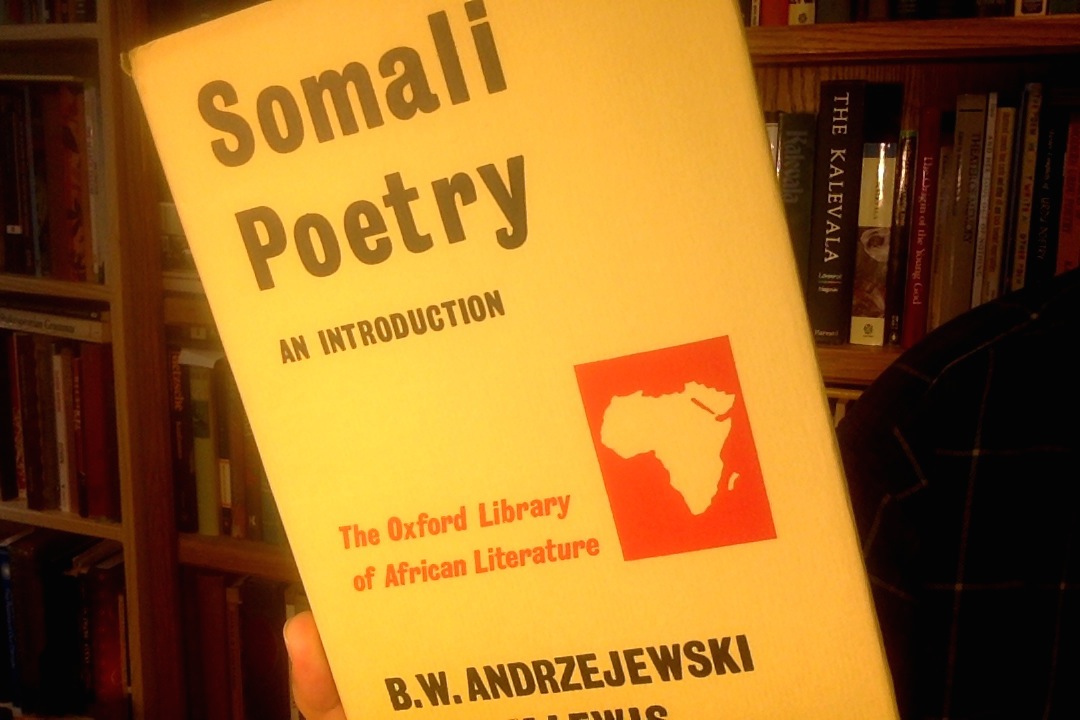Exhibit ‘K’: Somali. (Anonymous, [“Like a she-camel with a large bell…”])

Bibliography: Somali Poetry: An Introduction, B.W. Andrzejewski and I.M. Lewis (Oxford, 1964). The poem below appears on pages 142 (English) and 143 (Somali).
Backstory: Twenty-three years ago, a Philosophy major in a coffeehouse told me about a book called The Languages of the World (Funk and Wagnalls, 1975). It sounded like my kind of thing: samples of two hundred languages, each in its original orthography, with a half page of raw facts about where the language is spoken, how many speakers . . . also observations regarding anything that makes the language special. For example, in Malay,—
___________________
. . . [t]he plural of a noun is most commonly indicated by simply saying it twice, as in rumah-rumah [. . .] which means "houses." After numbers, however, the noun reverts to the singular and an additional word is added, similar to the English construction "seven head of cattle." Malay has many of these "numerical coefficients"—one for people (orang–man), one for animals (ekor–tail), and others for flowers, jewels, threads, and even fishing nets. "Two cats" in Malay is dua ekor kuching ("two-tail-cat"), while "two children" is budak dua orang ("child-two-man").
___________________
The above would've been plenty, but apparently the editor—one Kenneth Katzner—also had a connoisseur's eye for representative language specimens. Some of these were obvious enough: a paragraph of Madame Bovary for French, a paragraph of Don Quixote for Spanish. Nothing wrong with that. But things get really interesting when the languages are remote from the predictable course of study. Thai, Papago, Setswana—for languages like that, as often as not, the quoted passage would be a riddle or a piece of traditional poetry. Probably about a third of these items can be returned to over and over: stuff you might read to somebody over the phone.
When ordering books online became easy and normal, one of my first projects was to raid the bibliography of Languages of the World. The book pictured above was Katzner's source for the poem below.
["Like a she-camel with a large bell..."]
Like a she-camel with a large bell
Come from the plateau and upper Haud,
My heat is great.
Birds perched together on the same tree
Call each their own cries,
Every country has its own ways,
Indeed people do not understand each other's talk.
One of my she-camels falls on the road
And I protect its meat,
At night I cannot sleep,
And in the daytime I can find no shade.
I have broken my nose on a stick,
I have broken my right hip,
I have something in my eye,
And yet I go on.
•
Appendix: the original.
Sidii koorweyn halaad oo
Kor iyo Hawd sare ka timid
Kulayl badan baan qabaa
Shimbiro geed wada koraa
Midi ba cayn bay u cidaa
Carro ba waa camaladdeed
Illayn Lays me cod yaqaan
Hal baa hilin igaga jaban
Hilbaha yaan ka ceshadaa
Habeenkii ka ma lulmoodoo
Dharaartii ka ma hadh galo
Sankaa qori igaga jabay
Sintaa midig baan ka jabay
Il baa sachar igaga dhacay
Haddana waan soconayaa
•

Twenty-six items from Special Collections